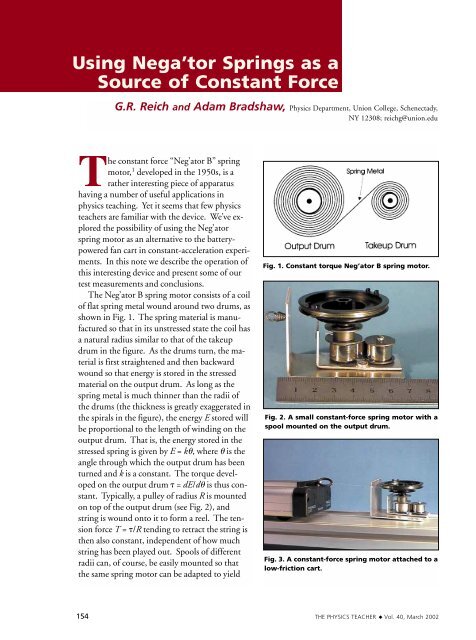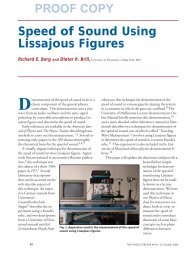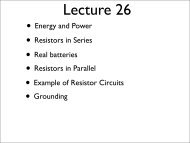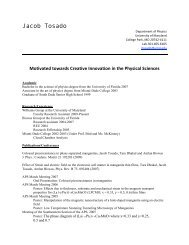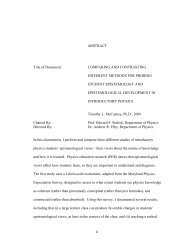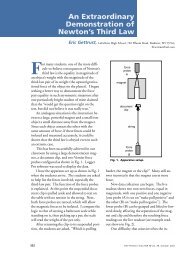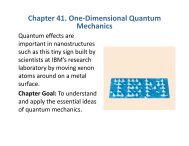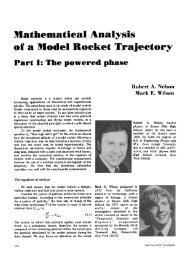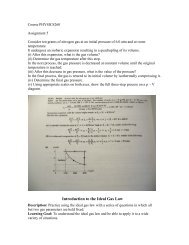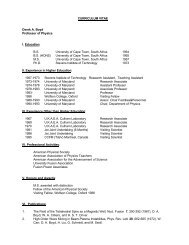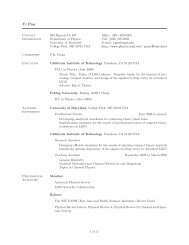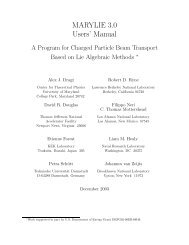Using Nega'tor Springs as a Source of Constant Force
Using Nega'tor Springs as a Source of Constant Force
Using Nega'tor Springs as a Source of Constant Force
You also want an ePaper? Increase the reach of your titles
YUMPU automatically turns print PDFs into web optimized ePapers that Google loves.
<strong>Using</strong> Nega’tor <strong>Springs</strong> <strong>as</strong> a<br />
<strong>Source</strong> <strong>of</strong> <strong>Constant</strong> <strong>Force</strong><br />
154<br />
G.R. Reich and Adam Bradshaw, Physics Department, Union College, Schenectady,<br />
NY 12308; reichg@union.edu<br />
The constant force “Neg’ator B” spring<br />
motor, 1 developed in the 1950s, is a<br />
rather interesting piece <strong>of</strong> apparatus<br />
having a number <strong>of</strong> useful applications in<br />
physics teaching. Yet it seems that few physics<br />
teachers are familiar with the device. We’ve explored<br />
the possibility <strong>of</strong> using the Neg’ator<br />
spring motor <strong>as</strong> an alternative to the batterypowered<br />
fan cart in constant-acceleration experiments.<br />
In this note we describe the operation <strong>of</strong><br />
this interesting device and present some <strong>of</strong> our<br />
test me<strong>as</strong>urements and conclusions.<br />
The Neg’ator B spring motor consists <strong>of</strong> a coil<br />
<strong>of</strong> flat spring metal wound around two drums, <strong>as</strong><br />
shown in Fig. 1. The spring material is manufactured<br />
so that in its unstressed state the coil h<strong>as</strong><br />
a natural radius similar to that <strong>of</strong> the takeup<br />
drum in the figure. As the drums turn, the material<br />
is first straightened and then backward<br />
wound so that energy is stored in the stressed<br />
material on the output drum. As long <strong>as</strong> the<br />
spring metal is much thinner than the radii <strong>of</strong><br />
the drums (the thickness is greatly exaggerated in<br />
the spirals in the figure), the energy E stored will<br />
be proportional to the length <strong>of</strong> winding on the<br />
output drum. That is, the energy stored in the<br />
stressed spring is given by E = k�, where � is the<br />
angle through which the output drum h<strong>as</strong> been<br />
turned and k is a constant. The torque developed<br />
on the output drum � = dE/d� is thus constant.<br />
Typically, a pulley <strong>of</strong> radius R is mounted<br />
on top <strong>of</strong> the output drum (see Fig. 2), and<br />
string is wound onto it to form a reel. The tension<br />
force T = �/R tending to retract the string is<br />
then also constant, independent <strong>of</strong> how much<br />
string h<strong>as</strong> been played out. Spools <strong>of</strong> different<br />
radii can, <strong>of</strong> course, be e<strong>as</strong>ily mounted so that<br />
the same spring motor can be adapted to yield<br />
Fig. 1. <strong>Constant</strong> torque Neg’ator B spring motor.<br />
Fig. 2. A small constant-force spring motor with a<br />
spool mounted on the output drum.<br />
Fig. 3. A constant-force spring motor attached to a<br />
low-friction cart.<br />
THE PHYSICS TEACHER ◆ Vol. 40, March 2002
Fig. 4. Position-time graph for a low-friction cart<br />
moving under the influence <strong>of</strong> a constant-force<br />
spring motor (solid line) and a similar motion <strong>of</strong> a<br />
PASCO fan cart.<br />
different tensions.<br />
For testing purposes we mounted a spool <strong>of</strong><br />
2.5-cm radius on the output drum <strong>of</strong> a spring<br />
motor 2 whose nominal advertised torque w<strong>as</strong><br />
0.01 N-m, producing a string tension <strong>of</strong> about<br />
0.35 N, similar to the thrust <strong>of</strong> a PASCO fan<br />
cart. 3 The string w<strong>as</strong> then attached to a low-friction<br />
cart rolling on an aluminum track (see Fig.<br />
3), and an ult<strong>as</strong>onic range finder (not shown),<br />
mounted at the opposite end <strong>of</strong> the track, w<strong>as</strong><br />
used to follow the motion. The cart w<strong>as</strong> projected<br />
away from the spring end, it slowed <strong>as</strong> the<br />
string played out about 1.0 m, and then it sped<br />
up <strong>as</strong> it returned. Figures 4 and 5 show the position-<br />
and velocity-time graphs <strong>of</strong> the cart (solid<br />
line) in comparison with a similar motion <strong>of</strong> a<br />
PASCO fan cart. While the spring-motor motion<br />
produced less noise in the motion sensor<br />
than the fan cart, its velocity-time graph had a<br />
greater change <strong>of</strong> slope on reversal than the fan<br />
cart. In the c<strong>as</strong>e <strong>of</strong> the fan cart, the change <strong>of</strong><br />
slope <strong>of</strong> about 20% seems to be due mainly to<br />
friction in the wheel bearings; in the c<strong>as</strong>e <strong>of</strong> the<br />
spring motor, an additional 20% change seems<br />
to arise from internal losses in the spring motor<br />
itself. It is not known to what extent that effect<br />
can be reduced by changes to manufacture or design,<br />
for example, by improving the bearings.<br />
The spring-motor pulley can also be used <strong>as</strong> a<br />
handheld puller. Students in laboratory are<br />
THE PHYSICS TEACHER ◆ Vol. 40, March 2002<br />
Fig. 5. Velocity-time graph for a low-friction cart<br />
moving under the influence <strong>of</strong> a constant-force<br />
spring motor (solid line) and a similar motion <strong>of</strong> a<br />
PASCO fan cart.<br />
sometimes <strong>as</strong>ked to pull on an object with constant<br />
force by keeping a rubber band stretched to<br />
a constant length <strong>as</strong> the object moves or by keeping<br />
a spring scale at a constant setting. It is always<br />
an awkward procedure, and, especially for<br />
the initial motion, the motion is usually quite<br />
jerky. Spring motors work more successfully at<br />
this since the force they exert does not depend<br />
on keeping a fixed amount <strong>of</strong> string played out.<br />
With a little practice, it is possible to keep incre<strong>as</strong>ing<br />
the string length even while the object<br />
reverses direction, thus avoiding the hysteresis<br />
effect mentioned above and maintaining a quite<br />
constant acceleration. It appears that Neg’ator B<br />
motors can be a useful alternative means <strong>of</strong> providing<br />
constant forces to moving objects.<br />
Acknowledgments<br />
The authors would like to thank S. Lepp for<br />
bringing these devices to our attention and for<br />
helpful discussions.<br />
References<br />
1. F. A. Votta, Jr., “Theory and design <strong>of</strong> long-deflection<br />
constant force spring elements,” Trans.<br />
ASME 74, 439 (1952).<br />
2. Available from McM<strong>as</strong>ter-Carr, New Brunswick,<br />
NJ, Part # 61115A1 ($59.); http://www.<br />
mcm<strong>as</strong>ter.com.<br />
3. PASCO catalog # ME-9485.<br />
155


